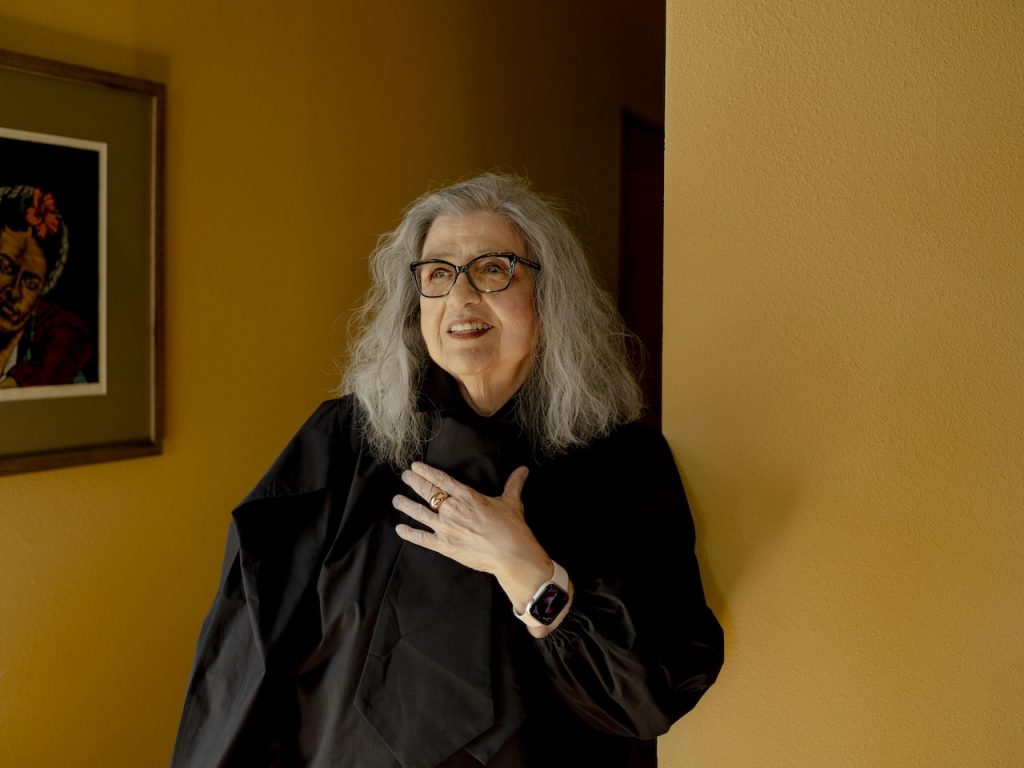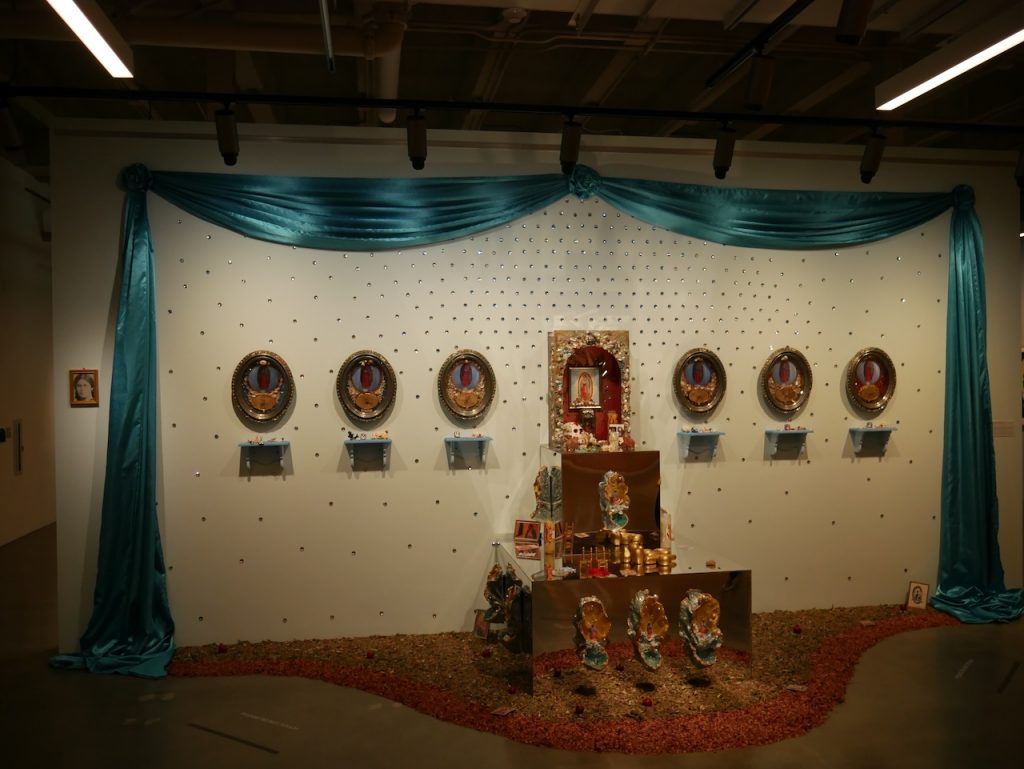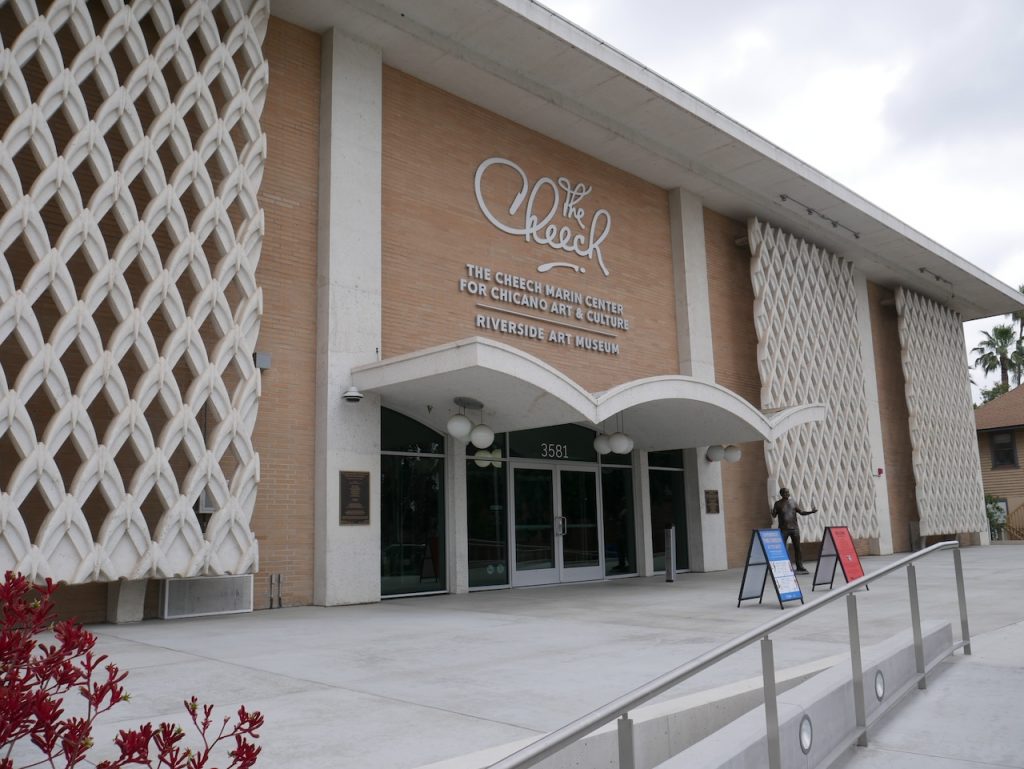
RIVERSIDE, Calif. — In Archaeology of Memory, now on view at The Cheech Marin Center for Chicano Art & Culture, the gallery glows with the intimacy of ritual: veils of lace drape over gilded mirrors, floors shimmer with poured wax, and the air seems to hum with the presence of saints, santos, and sacred relics. These are not merely installations. They are sites of remembrance, shaped by the hand and history of Amalia Mesa-Bains, one of the foundational figures in Chicana art.
Though Mesa-Bains has been exhibiting for decades—and is a MacArthur “genius” grant recipient—this marks her first career retrospective. The exhibition, spanning more than 40 years of work, reflects the vision of María Esther Fernández, artistic director of The Cheech Marin Center for Chicano Art & Culture, who curated the show. Fernández emphasizes the need for “repairing the canon,” recognizing the contributions of women, particularly women of color, whose legacies have too often been overlooked.
“I always start with conversations,” said María Esther Fernández, the artistic director of The Cheech and curator of the exhibition. “I want to understand the critical biography, how they grew up, how they became who they are. Sometimes there are great stories of family support; sometimes there aren’t. In Amalia’s case, it was really interesting to see how the women in her life shaped who she is.”


Fernández emphasized that, despite Mesa-Bains’s accolades and influence—as a writer, educator, and artist—she had never received a retrospective of this scale. “She had solo shows, like at the Sonoma Museum and Fresno, but nothing like this,” she said. “That’s where my research began—thinking about the retrospective as repair.”
The retrospective, Fernández added, resists easy categorization. “Even if artists resist labels, ‘I’m not Chicana,’ or ‘I’m creating my own language’, there is still a lineage. I think it’s important to recognize that.”
It’s a throughline she carries into her curatorial work more broadly. “That’s the kind of work I try to bring to The Cheech,” she said. “It aligns with what Cheech was doing from the beginning, collecting this work because it matters, because no one else was doing it.”
At The Cheech, that lineage is now on full view. “We’re at a moment where institutions are catching up to what these artists have always known,” Fernández added. “Their stories aren’t just valuable, they’re foundational.”

To experience Amalia Mesa-Bains: Archaeology of Memory in person, visit The Cheech Marin Center for Chicano Art & Culture at the Riverside Art Museum. The exhibition, which spans over three decades of Mesa-Bains’ groundbreaking work, will be on view until August 2025. For more information, including hours and admission, visit the Riverside Art Museum website at riversideartmuseum.org.
Memoria Sagrada y Reparación Cultural: Amalia Mesa-Bains en The Cheech
RIVERSIDE, California — En Archaeology of Memory, ahora en exhibición en The Cheech Marin Center for Chicano Art & Culture, la galería brilla con la intimidad del ritual: velos de encaje cubren espejos dorados, los suelos brillan con cera vertida, y el aire parece vibrar con la presencia de santos y reliquias sagradas. No son simplemente instalaciones. Son sitios de memoria, moldeados por la mano y la historia de Amalia Mesa-Bains, una de las figuras fundacionales del arte chicano.
Aunque Mesa-Bains ha expuesto durante décadas—y es ganadora del prestigioso premio MacArthur “genius”—esta es su primera retrospectiva de carrera. La exposición, que abarca más de 40 años de trabajo, refleja la visión de María Esther Fernández, directora artística de The Cheech Marin Center for Chicano Art & Culture, quien curó la muestra. Fernández destaca la necesidad de “reparar el canon”, reconociendo las contribuciones de mujeres, en particular mujeres de color, cuyas trayectorias han sido ignoradas con demasiada frecuencia.
“Siempre comienzo con conversaciones,” dijo María Esther Fernández, directora artística de The Cheech y curadora de la exposición. “Quiero entender la biografía crítica: cómo crecieron, cómo se convirtieron en quienes son. A veces hay grandes historias de apoyo familiar; a veces no. En el caso de Amalia, fue muy interesante ver cómo las mujeres en su vida moldearon quién es.”
Fernández enfatizó que, a pesar de los reconocimientos y la influencia de Mesa-Bains—como escritora, educadora y artista—nunca había recibido una retrospectiva de esta magnitud. “Tuvo exposiciones individuales, como en el Museo de Sonoma y en Fresno, pero nada como esto,” dijo. “Ahí comenzó mi investigación—pensar en la retrospectiva como una forma de reparación.”
La retrospectiva, añadió Fernández, desafía la categorización fácil. “Incluso si los artistas rechazan etiquetas—‘No soy chicana,’ o ‘Estoy creando mi propio lenguaje’—aún hay un linaje. Creo que es importante reconocerlo.”
Ese mismo hilo conductor está presente en su labor curatorial en general. “Ese es el tipo de trabajo que intento traer a The Cheech,” dijo. “Se alinea con lo que Cheech hacía desde el principio: coleccionar este trabajo porque importa, porque nadie más lo estaba haciendo.”
En The Cheech, ese linaje ahora está plenamente visible. “Estamos en un momento donde las instituciones están alcanzando lo que estos artistas siempre han sabido,” añadió Fernández. “Sus historias no solo son valiosas, son fundamentales.”
Para experimentar Amalia Mesa-Bains: Archaeology of Memory en persona, visite The Cheech Marin Center for Chicano Art & Culture en el Riverside Art Museum. La exhibición, que abarca más de tres décadas de trabajo innovador de Mesa-Bains, estará disponible hasta agosto de 2025. Para más información, incluidos horarios y boletos, visite el sitio web del Riverside Art Museum en riversideartmuseum.org.
Article by Pollyana Ramos Tucker
